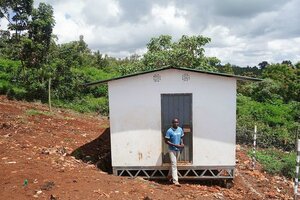Build a solar-powered school in rural Kenya – in 48 hours
The flat-packed building kit from Aleutia, a British tech company, includes computers preloaded with educational resources.

Aleutia, a British tech company, is rolling out its 'Solar Classroom in a Box' in 47 locations across Kenya. The pilot project provides prefabricated, tech-enabled school buildings. Flat-packed like an Ikea dresser, the structures are easy to ship and assemble, and they are powered with energy from the sun.
Courtesy of Aleutia/Twitter
Sunshine is abundant in rural Kenya. Traditional electrical wires that connect to a power grid are not.
That lack of electricity makes life difficult for the people who live beyond the African nation’s bustling cities, including hundreds of thousands of kids who might not have access to schools—let alone the well-lit, technologically equipped classrooms that children in the developed world often take as a given.
So Aleutia, a U.K.–based tech company, is rolling out its “Solar Classroom in a Box” in 47 locations across the country. The pilot project provides prefabricated, tech-enabled school buildings. Flat-packed like an Ikea dresser, the structures are easy to ship and assemble, and they are powered with energy from the sun.
Kenya’s need for such schools is real. More than 1 million children are out of school, according to UNESCO, and three-fourths of Kenyans live in rural areas. Aleutia hopes its plug-and-play pilot program will help give 20,000 Kenyan children access to basic education.
The company considered using shipping containers for the effort but soon discarded that idea.
“The problem we discovered was that the local supply of containers was very cheap but typically rusty, and retrofitting and adapting them was expensive,” Mike Rosenberg, the director of Aleutia, told Gizmag. “Transport costs for a flatbed truck are very high and even higher for a crane, which is required to lower [the containers] onto a foundation. So we pivoted.”
Instead, according to the Aleutia blog, each solar classroom comes in a kit “that can be transported in a pickup or cattle truck.” Once the box is opened, no construction workers or expensive equipment are required for assembly. A 20-by-10-by-8-foot classroom can be put together in about two days by an average person with a screwdriver—which is included in the box.
The classroom kit also contains 11 computers—10 for students and one for a teacher—that come preloaded with offline information from Wikipedia, as well as lessons from the free digital education service Khan Academy. Once the school is erected and the solar panels are providing electricity, the computers can be plugged in, providing a resource that teachers can use to prepare for lessons and pupils can access to complete assignments.
The first school, in Kiambu County, just north of Nairobi, went up at the end of July, and the company hopes to finish the rest over the next few months.
• Staff writer Liz Dwyer has written about race, parenting, and social justice for several national publications. She was previously education editor at Good.
• This article originally appeared at TakePart, a leading source of socially relevant news, features, opinion, entertainment, and information – all focused on the issues that shape our lives.

